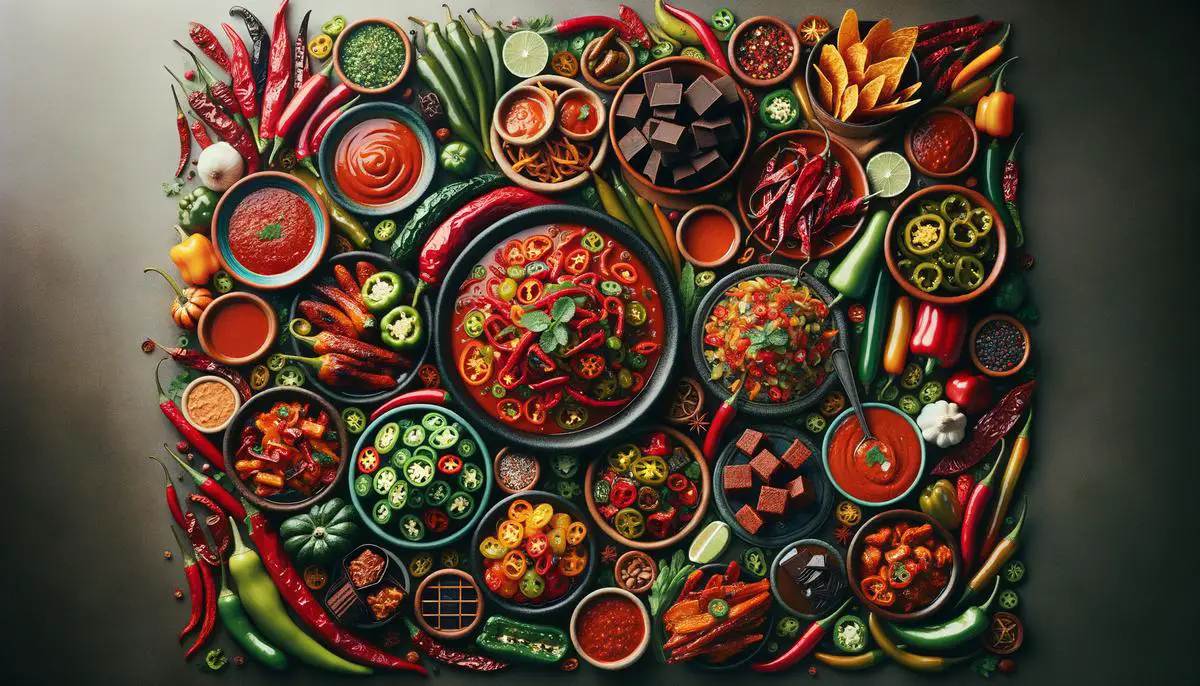
Cultivation and Harvesting Practices
The cultivation of New Mexican chiles is a process deeply rooted in tradition, innovation, and the unique geography that sets these vibrant pods apart in the culinary world. Thriving in the sun-drenched soils of New Mexico, these chiles benefit from a combination of hot days, cool nights, minimal rainfall, and an altitude that stresses the plants just enough to intensify their flavors and heat profiles.1 This singular combination of factors contributes to creating chiles with an earthy, sweet flavor paired with a distinct, mellow heat not found in other varieties. The Hatch Valley, often referred to as the "Chile Capital of the World," offers an unparalleled terroir that imbues these peppers with a flavor profile revered by chefs and food aficionados alike.
The cultivation practices associated with New Mexican chiles highlight a commitment to quality and tradition. Farmers in the region often follow generations-old planting and harvesting methods, ensuring each batch of chiles represents the rich cultural heritage of the area. The strategic use of drip irrigation – a water-efficient method that supplies water directly to the roots – addresses the arid conditions of the region and fosters a more potent chile.2 Despite challenges like erratic weather patterns, climate changes, and water scarcity, the resilient spirit of New Mexican chile growers shines through. Their adept management and innovative agricultural practices allow them to continue producing a crop that stands as a proud emblem of New Mexican heritage and culinary innovation.
Culinary Uses and Recipes
In the realm of culinary applications, New Mexican chiles are pivotal ingredients across an array of dishes that define Southwestern cuisine and beyond. These chiles, celebrated for their versatile heat profile and robust earthy flavors, are incorporated in ways that elevate recipes to new heights. In kitchens where tradition meets innovation, New Mexican chiles are often found as:
- Powders
- Flakes
- Integral components of complex sauces that serve as the backbone of numerous iconic dishes
The Chile Colorado, for example, is renowned for its deep, inviting color and rich flavor profile, underscoring the chiles' ability to function as more than just a spice.
These chiles' transformative potential is also unleashed in innovative culinary creations, demonstrating their adaptability beyond traditional Southwestern dishes. Chefs integrate New Mexican chiles into chocolate treats, offering a tantalizing balance of sweet and heat that surprises and delights the palate. The subtle yet distinct smoky undertones of these chiles enrich marinades, lending depth to grilled meats and vegetables. Their dried forms, readily reconstituted, are a chef's ally in crafting sauces and salsas where they meld harmoniously with ingredients like tomatoes and chocolate, bridging flavors and adding layers of complexity. The broad application of New Mexican chiles reflects their culinary versatility, enshrining them as indispensable in kitchen pantries far beyond their native soil.

Health Benefits and Nutritional Values
Integrating New Mexican chiles into your diet can provide numerous health benefits, thanks to their unique composition. Rich in vitamins A and C, these chiles offer a wealth of antioxidants, crucial in fighting free radicals and bolstering the immune system.3 The vibrant reds and greens of these chiles not only add aesthetic value to dishes but also act as defenses against common ailments, enhancing your body's natural defenses while pleasing your taste buds.
The capsaicin in New Mexican chiles, responsible for their trademark kick, also acts as a health ally, accelerating metabolism and promoting fat burning. This can be an integral part of a weight management plan, where adding a dash of ground New Mexican chile to your meals not only elevates the dish but also assists in maintaining a healthy weight. Furthermore, capsaicin's ability to alleviate pain by diminishing substance P — a chemical that signals pain to the brain — renders these chiles not just culinary delights but therapeutic aids.4
Including New Mexican chiles in your daily diet is a small shift that can lead to a healthier lifestyle. With countless ways to incorporate them, from salsas to stews, these chiles bring complex flavors and considerable health benefits. Their gentle warmth allows the savvy eater to enjoy a symphony of flavors while reaping the rewards of their nutritional value. Exploring the distinctive flair these chiles bring is an investment in flavor with dividends paid in health.
New Mexican chiles have a profound impact on our culinary experiences and health. Their ability to infuse dishes with depth while offering substantial health benefits underscores their value beyond mere flavor enhancers. As we savor the warmth they bring to our meals, we also embrace the cultural heritage and nutritional wealth they carry with them.
- Bosland PW, Walker SJ. Growing chiles in New Mexico. New Mexico State University Cooperative Extension Service. 2014;H-230:1-8.
- Sammis TW, Shukla MK, Mexal JG, Bosland PW, Daugherty LA. Improving irrigation efficiency of chile pepper using plastic mulch and drip irrigation. Agricultural Water Management. 2012;109:11-19.
- Hernández-Ortega M, Ortiz-Moreno A, Hernández-Navarro MD, Chamorro-Cevallos G, Dorantes-Alvarez L, Necoechea-Mondragón H. Antioxidant, antinociceptive, and anti-inflammatory effects of carotenoids extracted from dried pepper (Capsicum annuum L.). Journal of Biomedicine and Biotechnology. 2012;2012:524019.
- Fattori V, Hohmann MS, Rossaneis AC, Pinho-Ribeiro FA, Verri WA. Capsaicin: Current understanding of its mechanisms and therapy of pain and other pre-clinical and clinical uses. Molecules. 2016;21(7):844.



